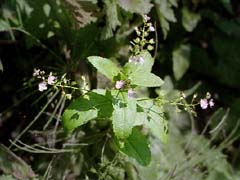Scrophulariaceae (Figwort Family)
Scrophulariaceae, or Figwort, is often referred to as the Snapdragon Family. It is well represented on the coast and throughout the Bay Area, and many of it's species have been cultivated for commercial flower production. The family contains 3 of the most well-known California native plants: Paintbrush, Monkey Flower, and Beeplant. Some of the species are semi-parasitic, especifically the Castilleja (paintbrush), which derive some of their nutrients by joining their roots to those of other plants.
Scrophulariaceae flowers have distinctly two-lipped corollas, with the upper lip divided into 2 lobes, and the lower into 3. Mostly. The calyx is usually five-lobed, but may be four-lobed. Most have 2 pairs of stamen, but there may from 2 to 5, in pairs or individual.

